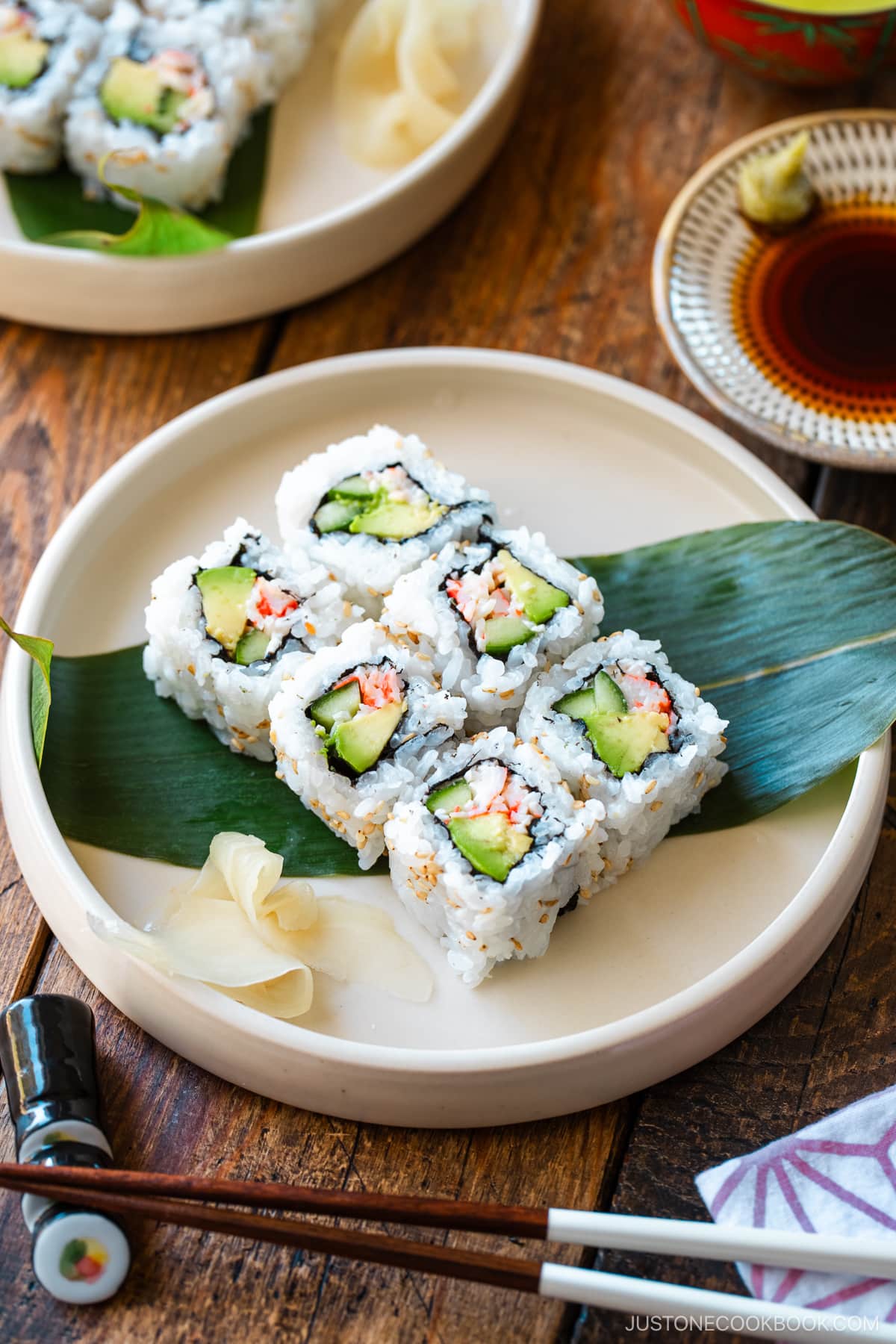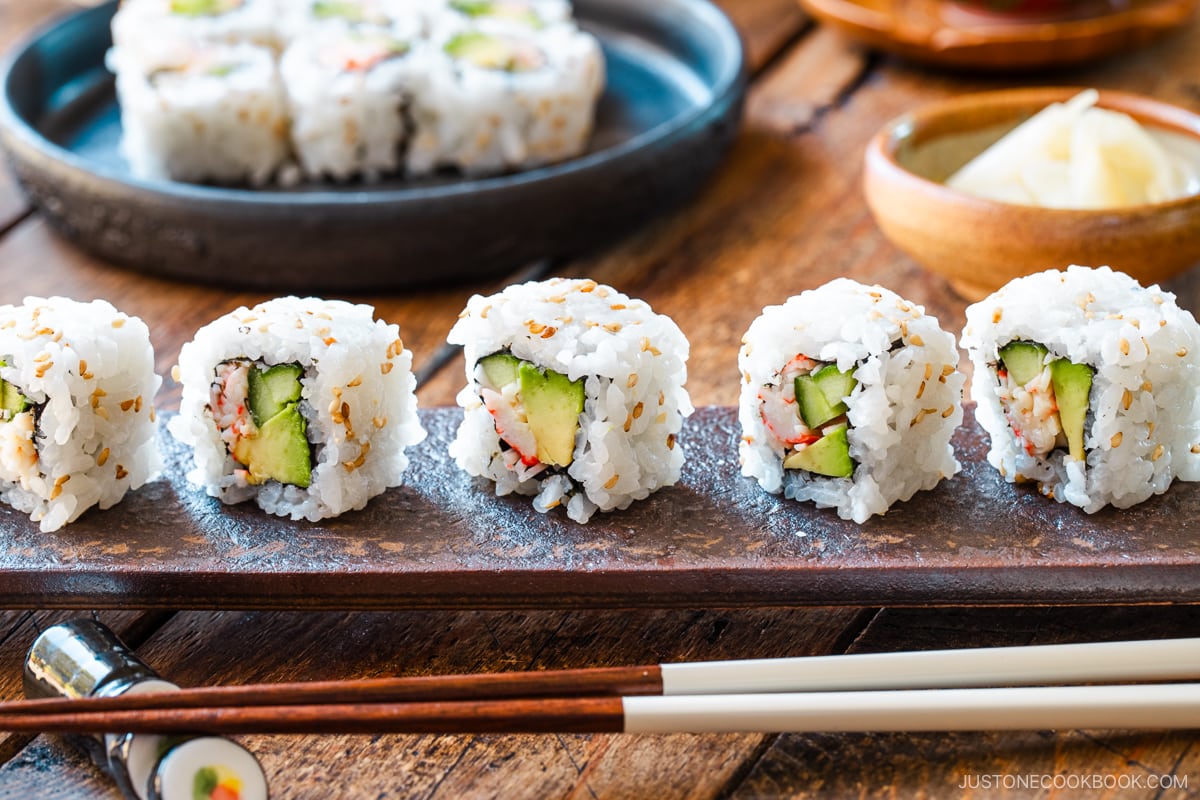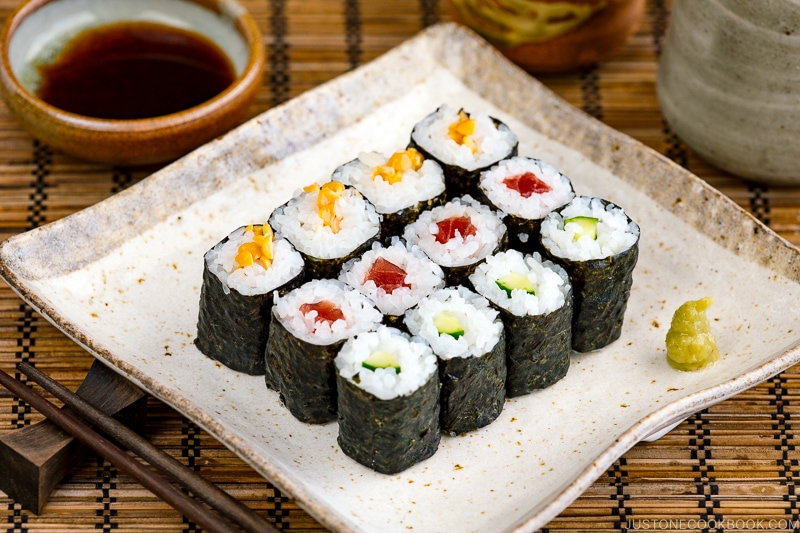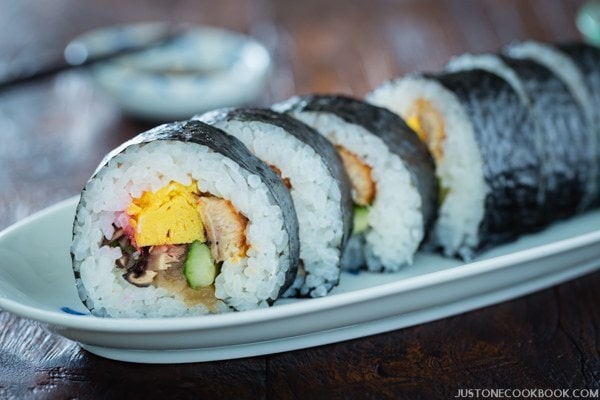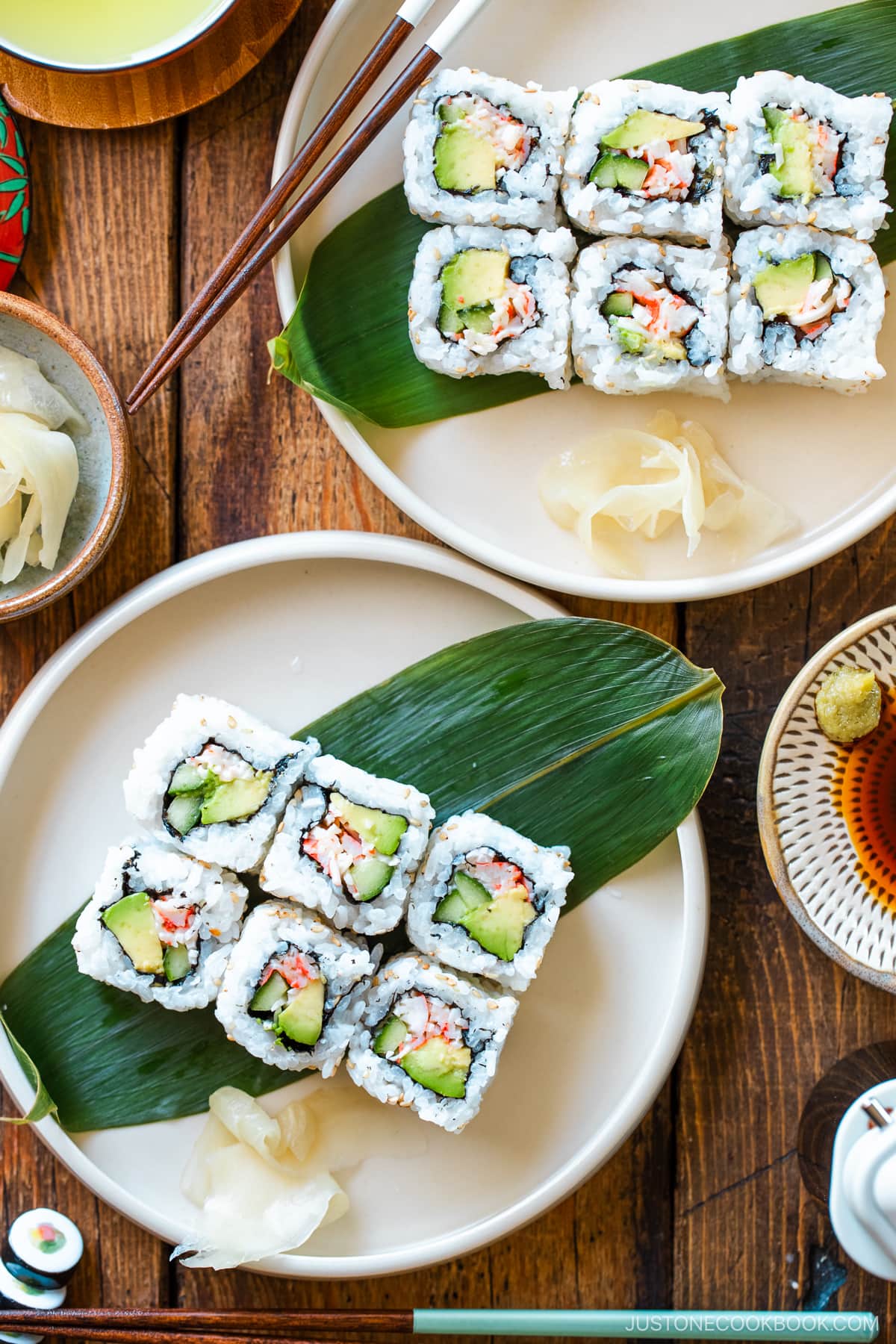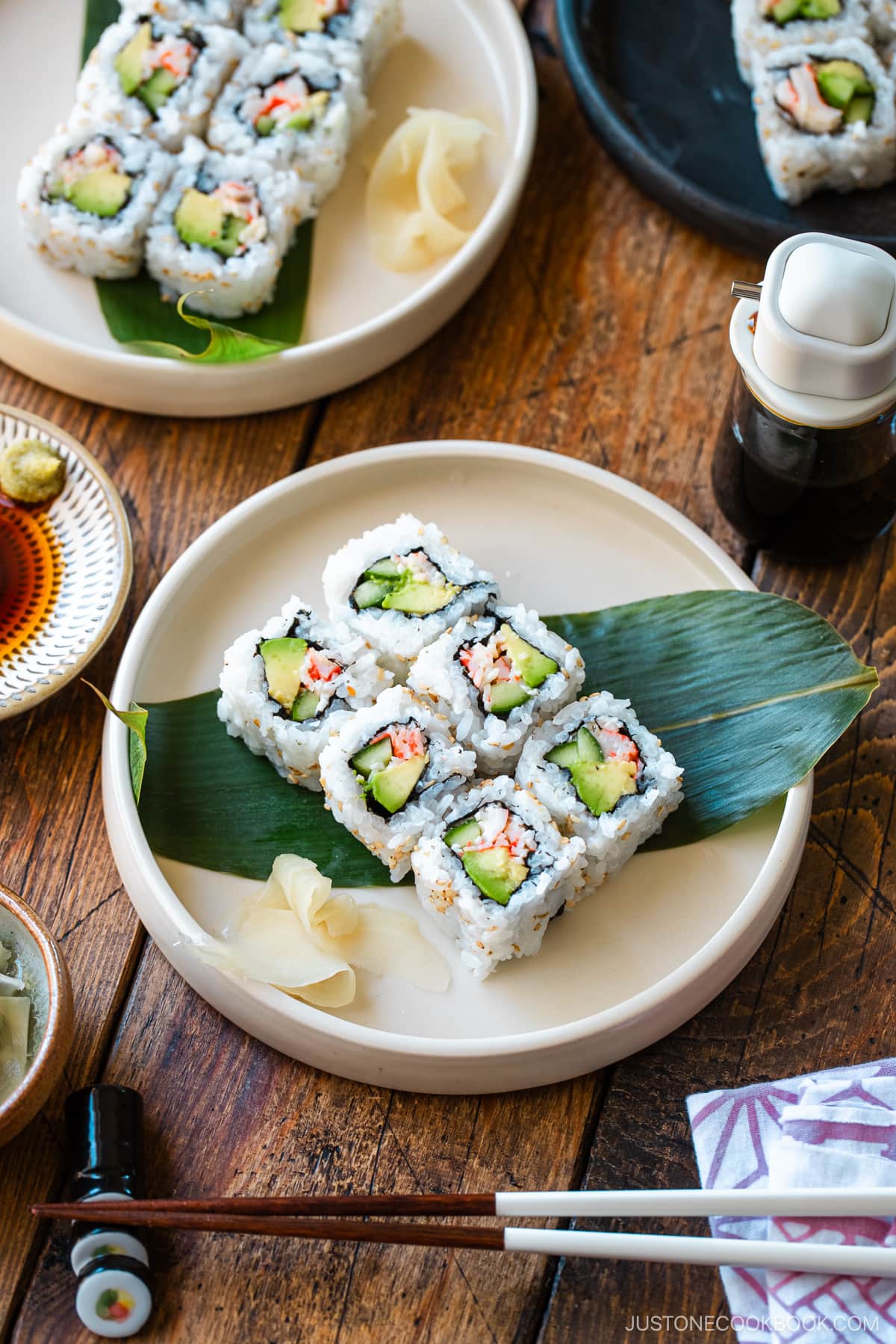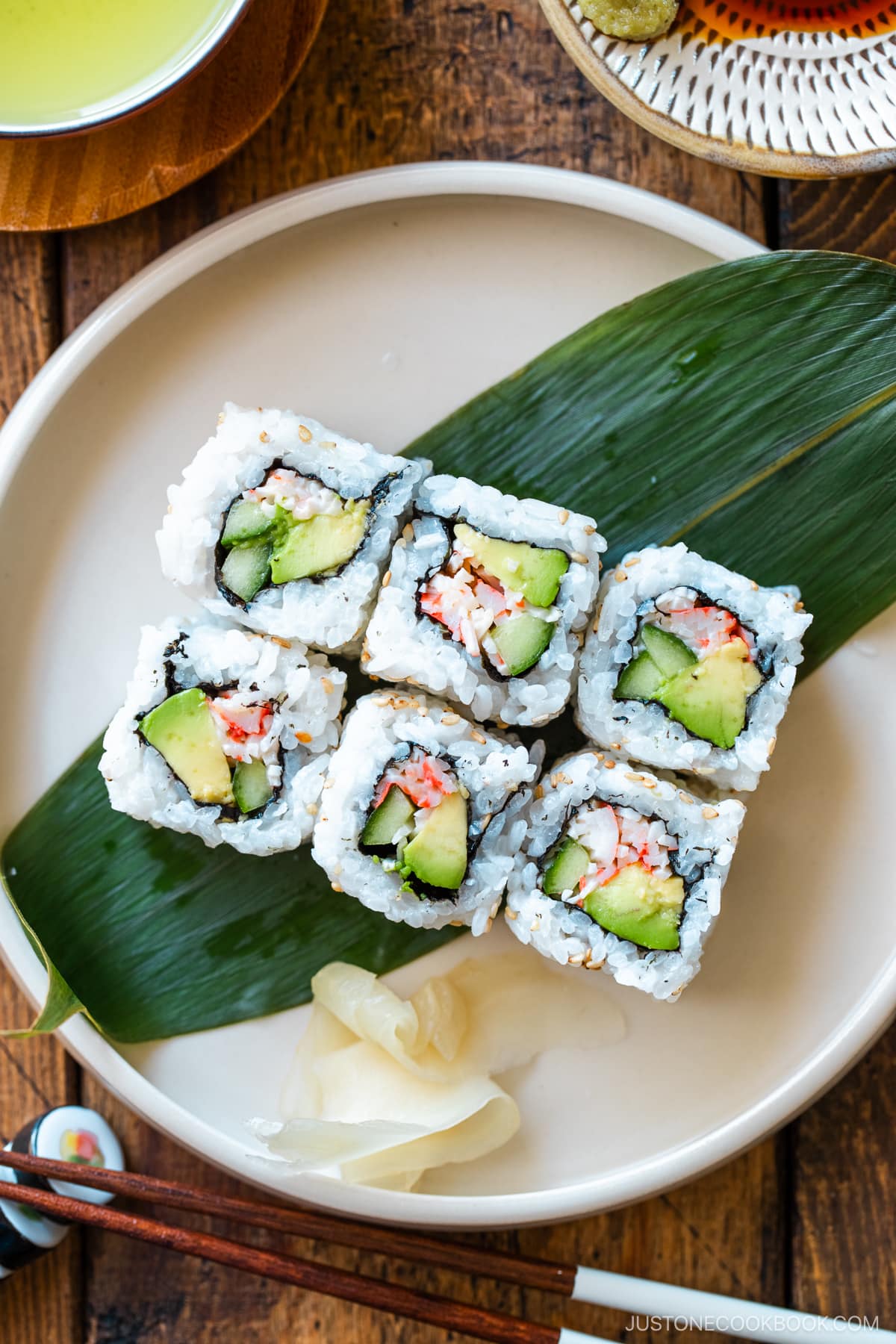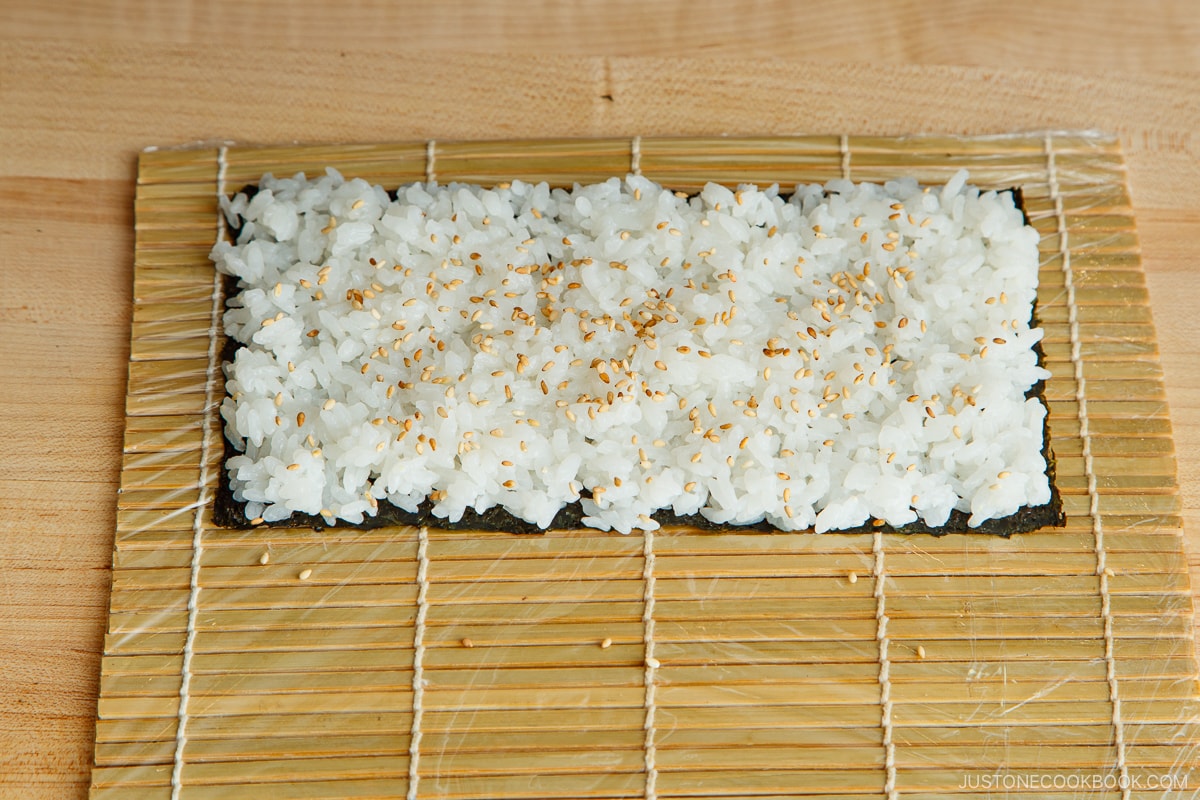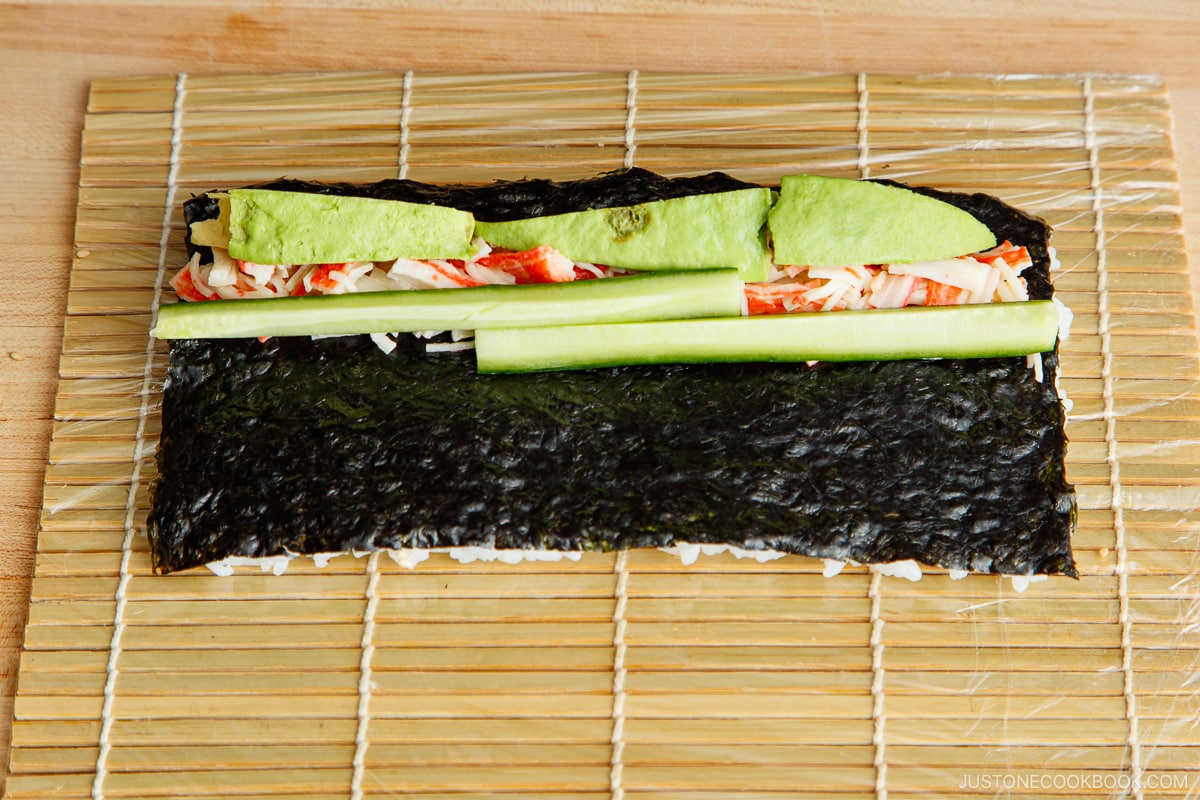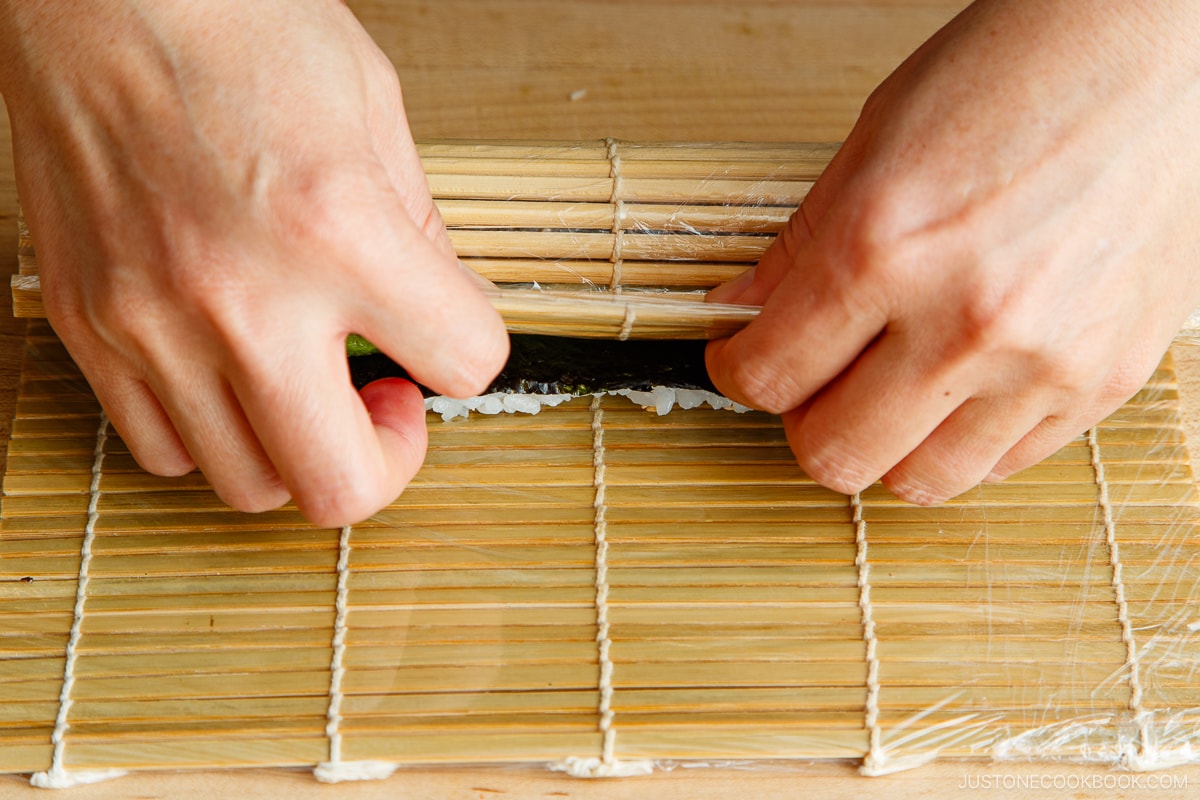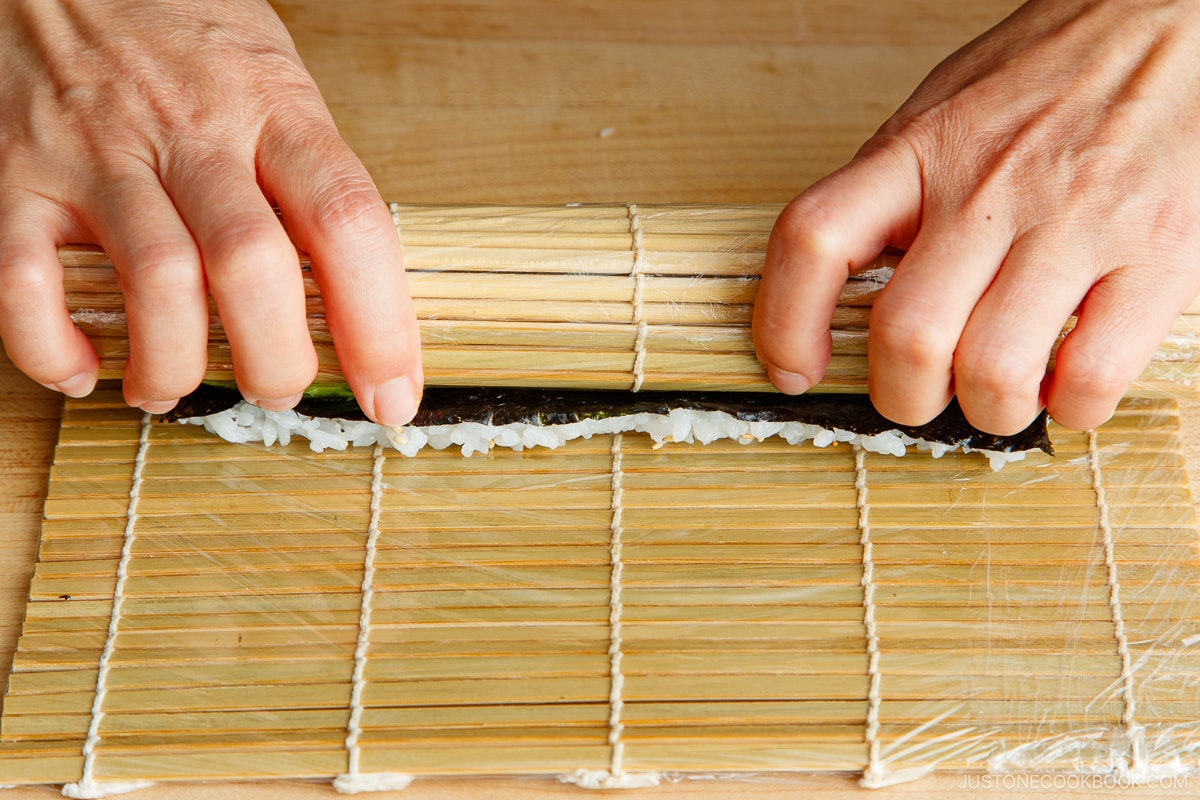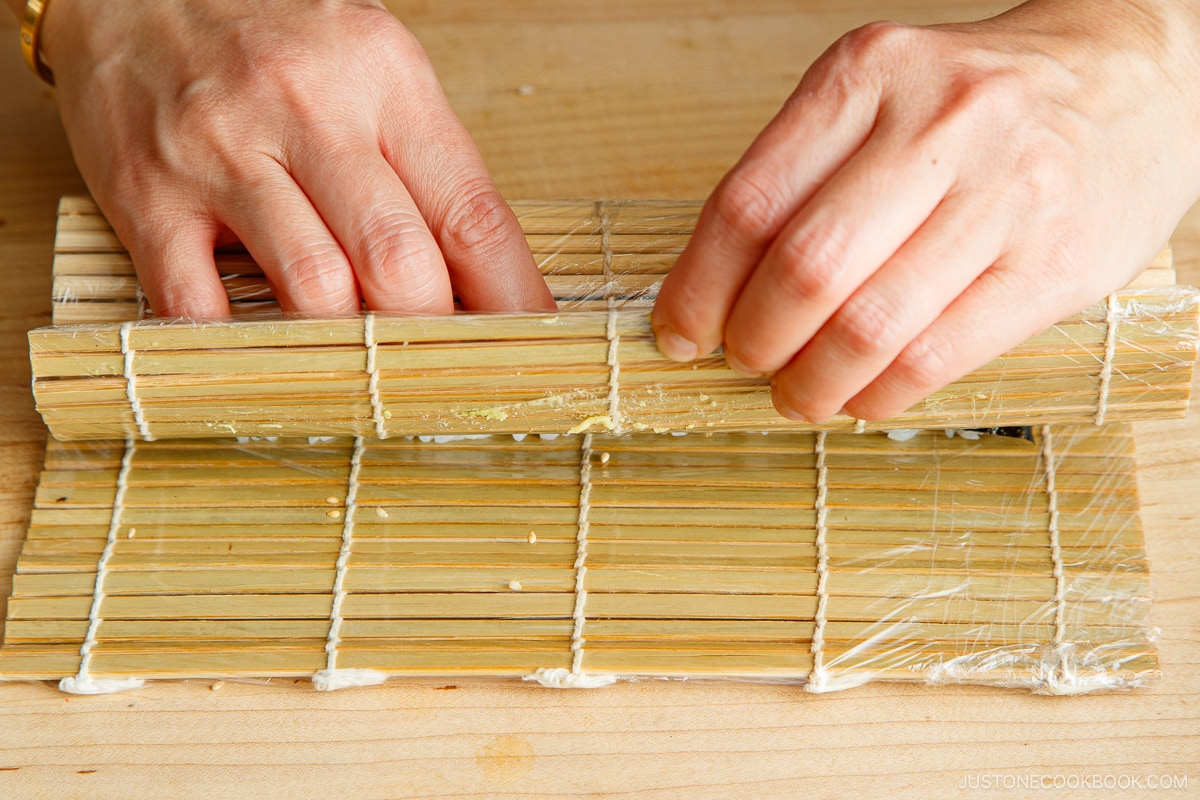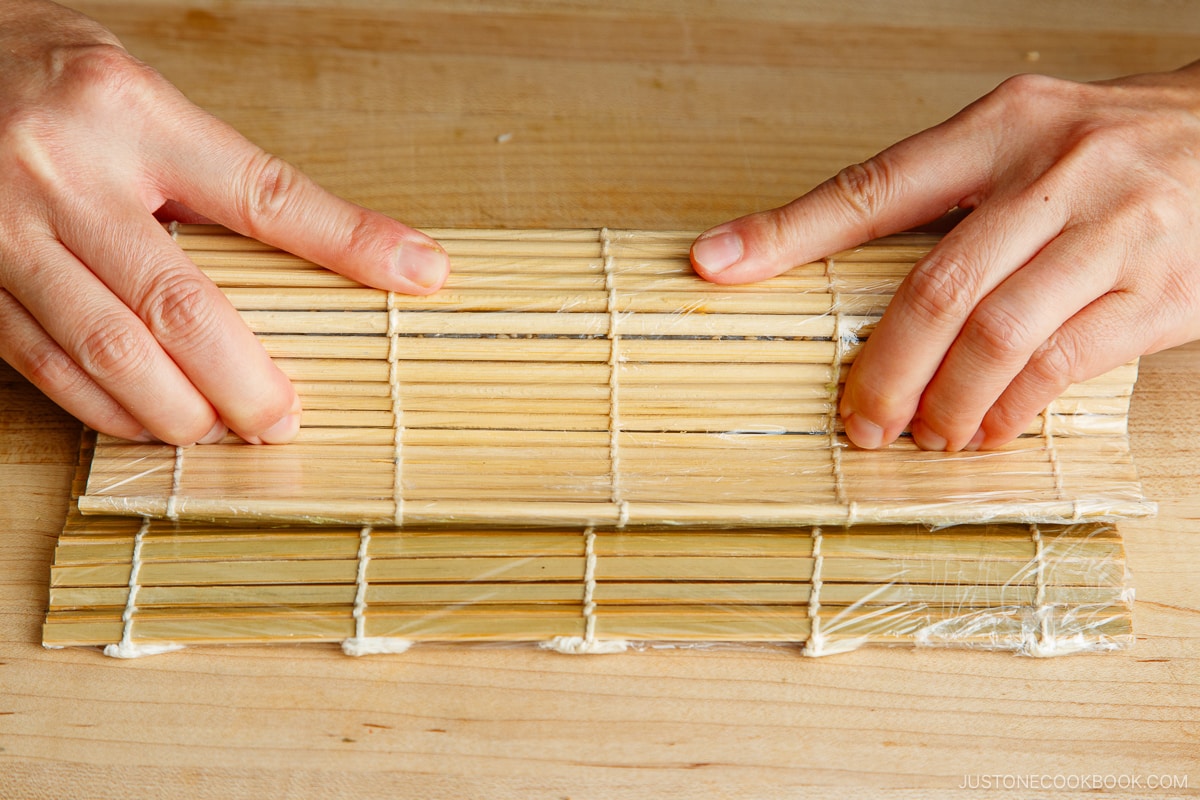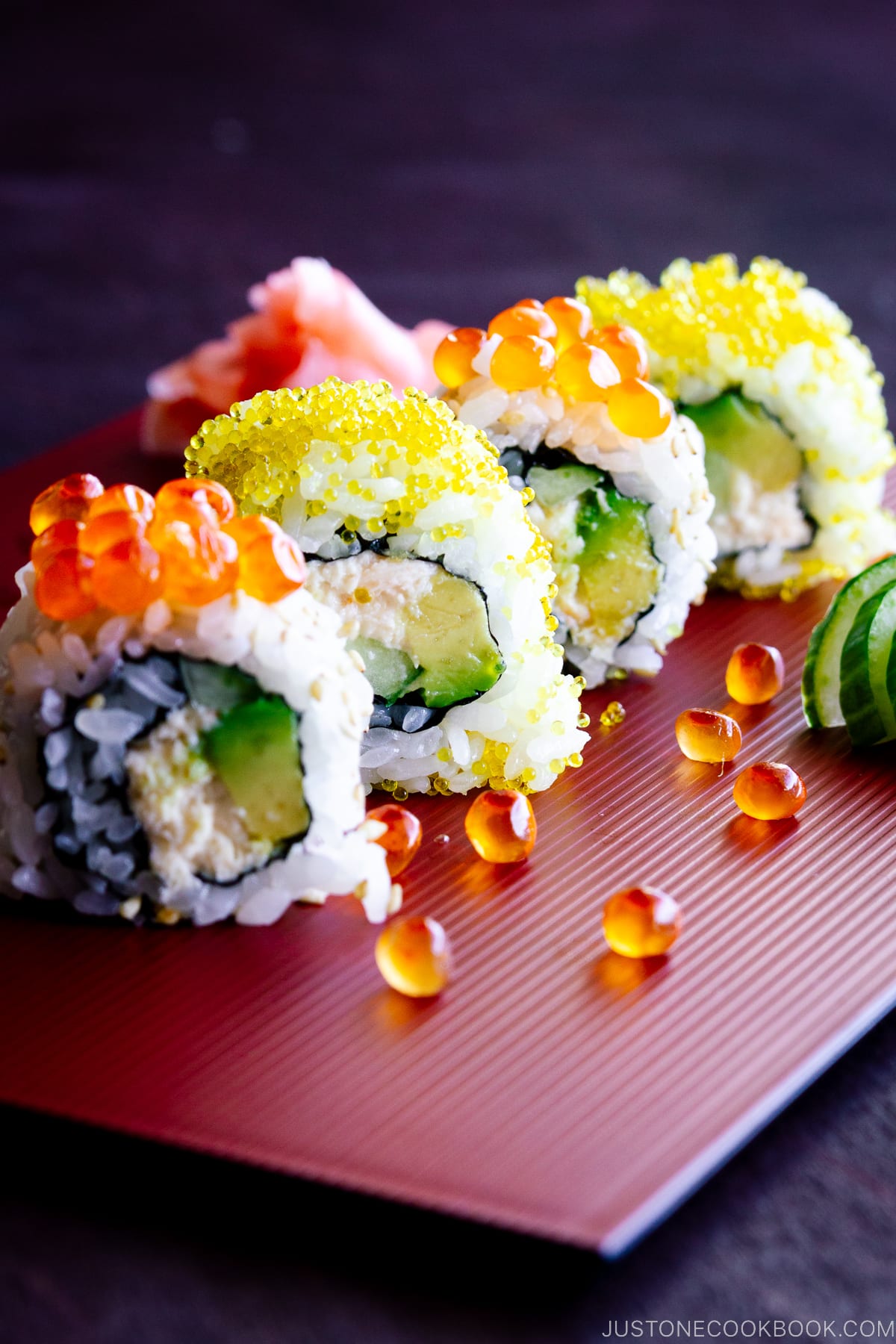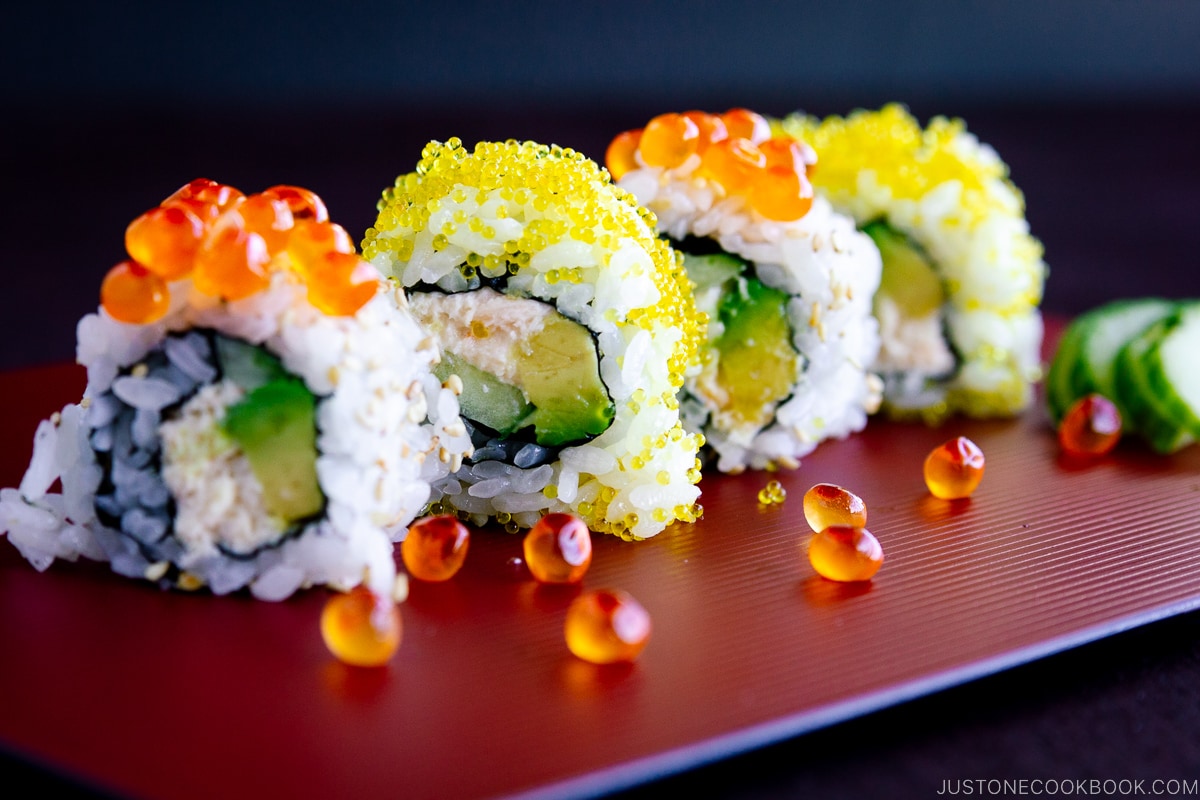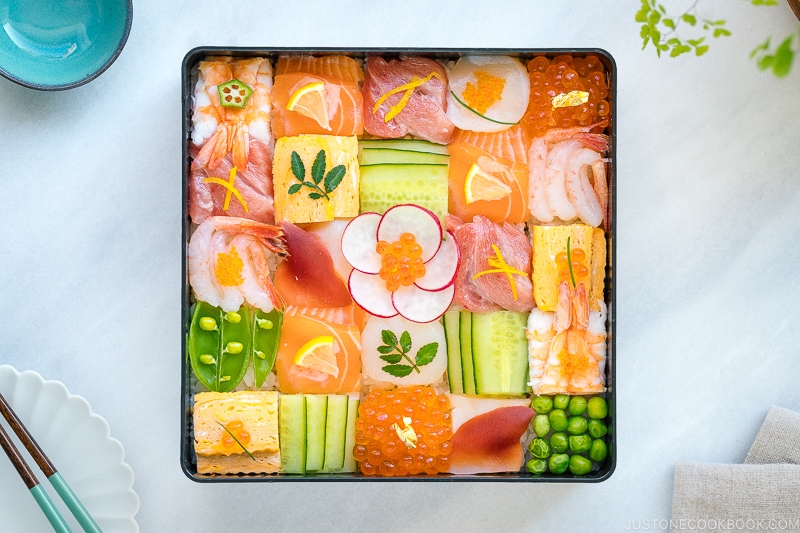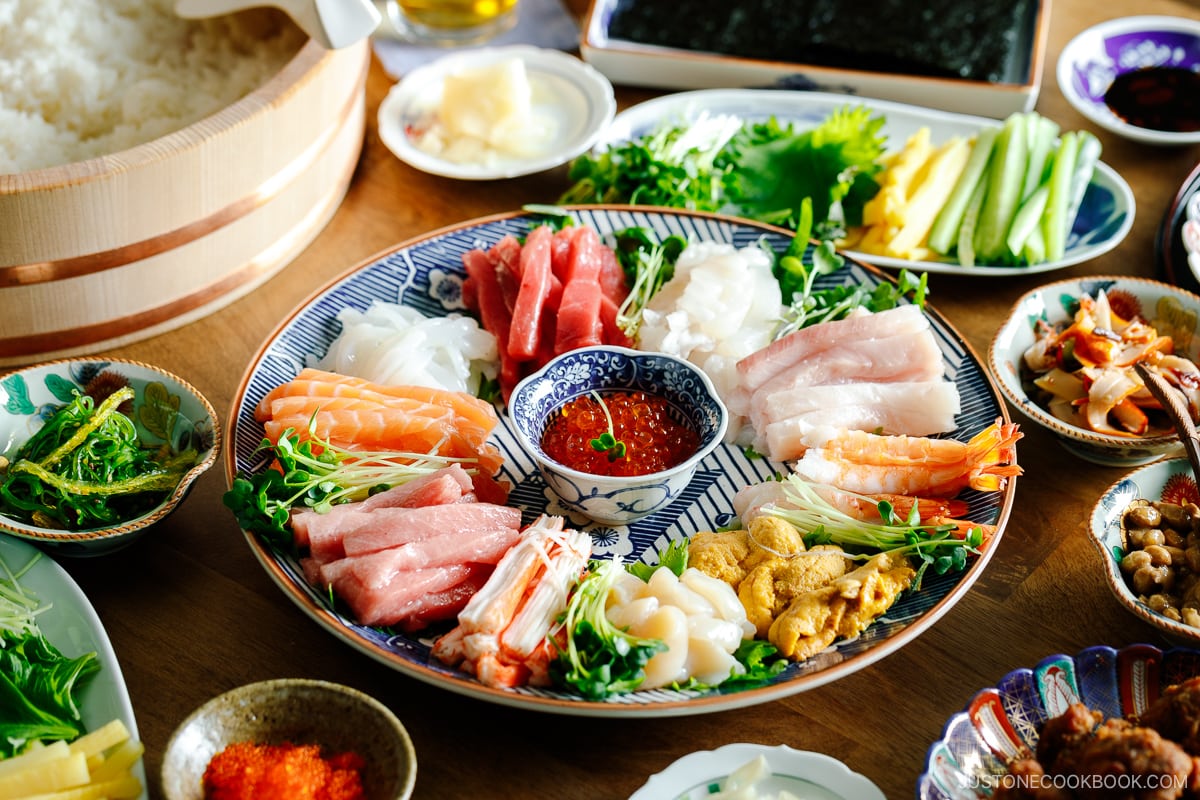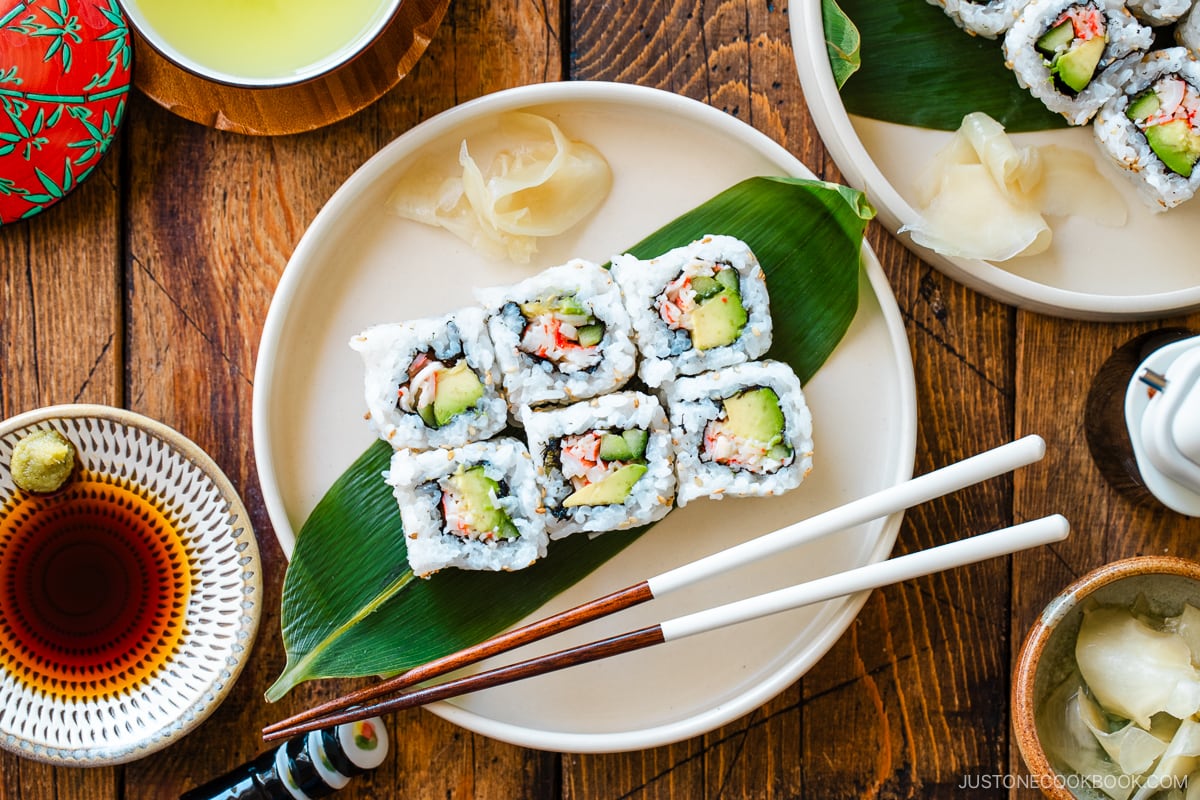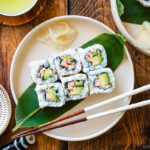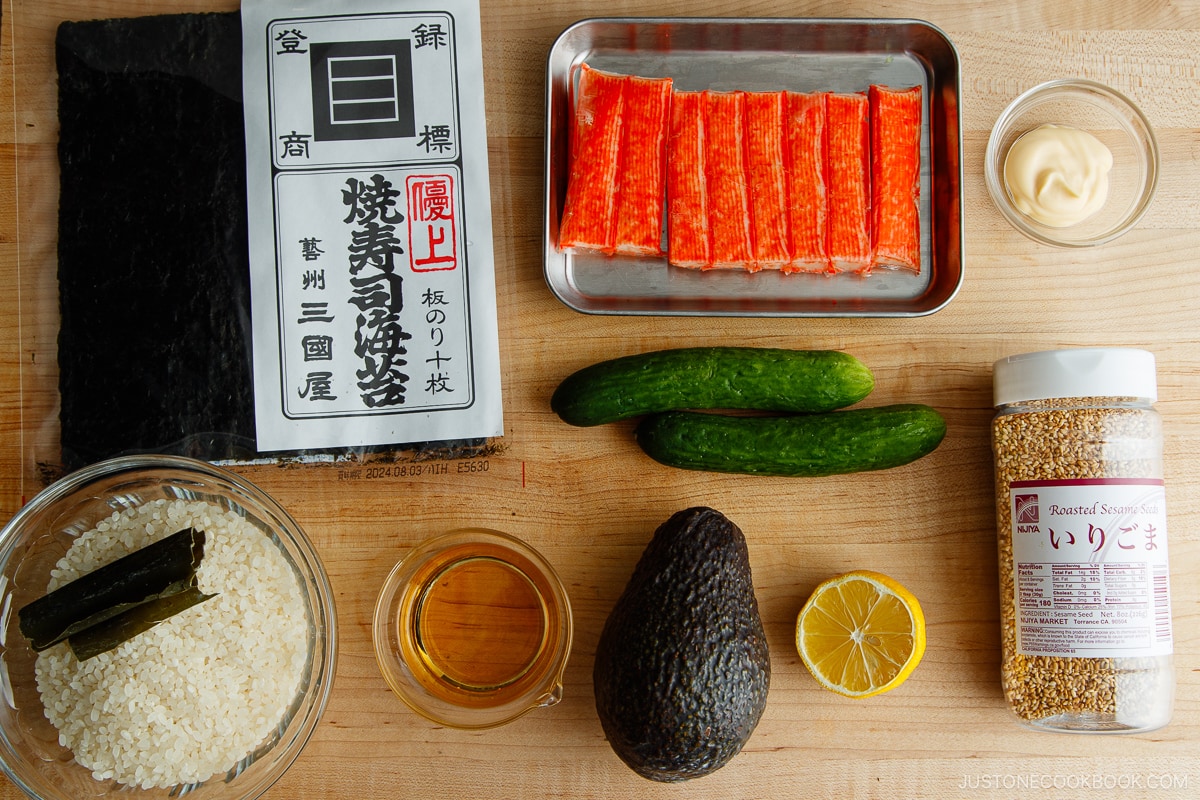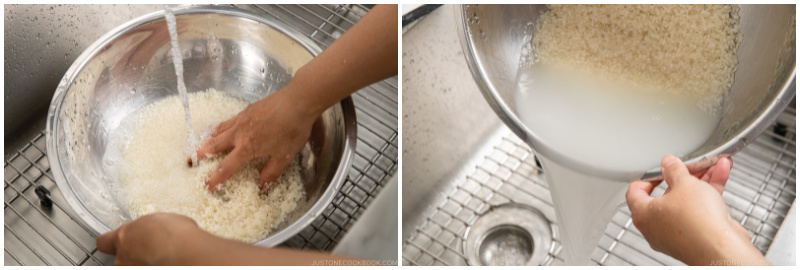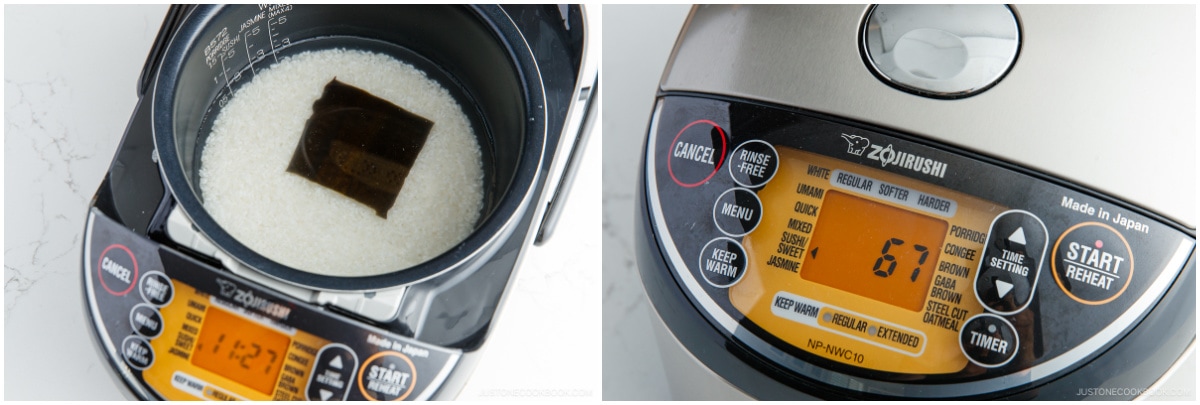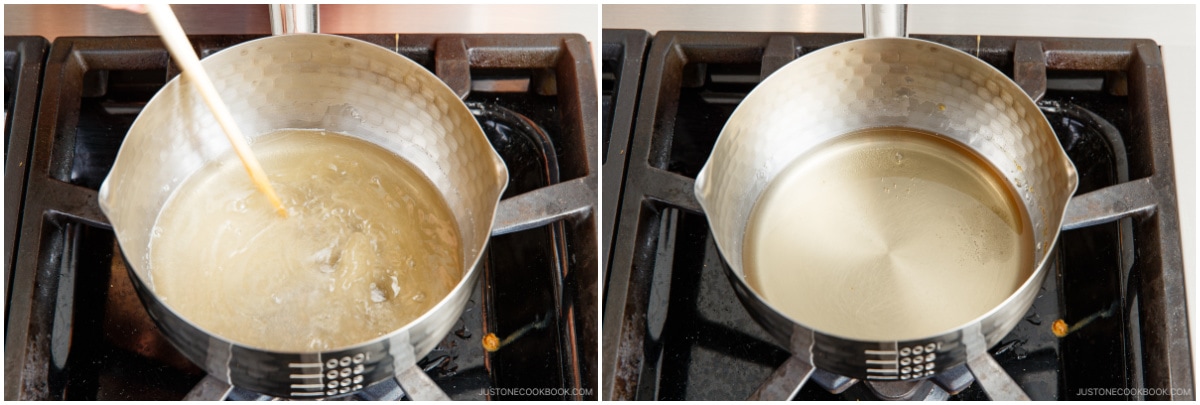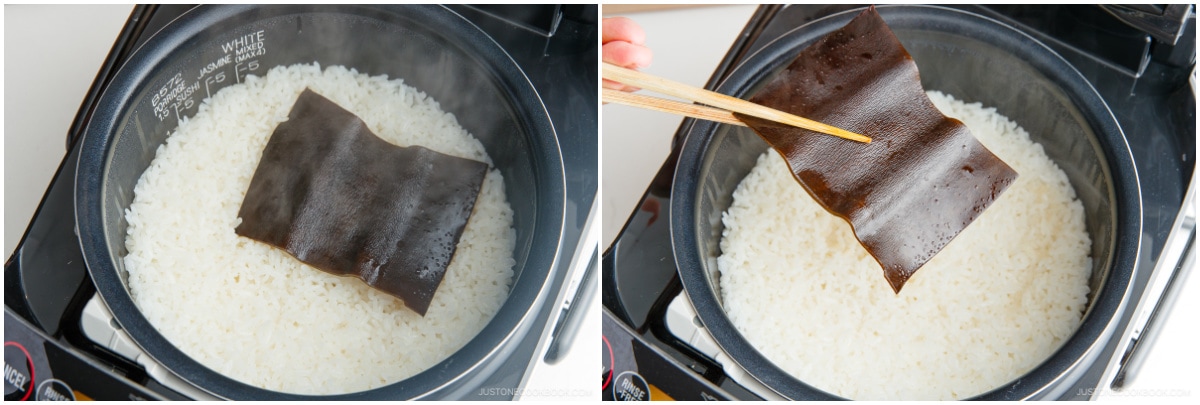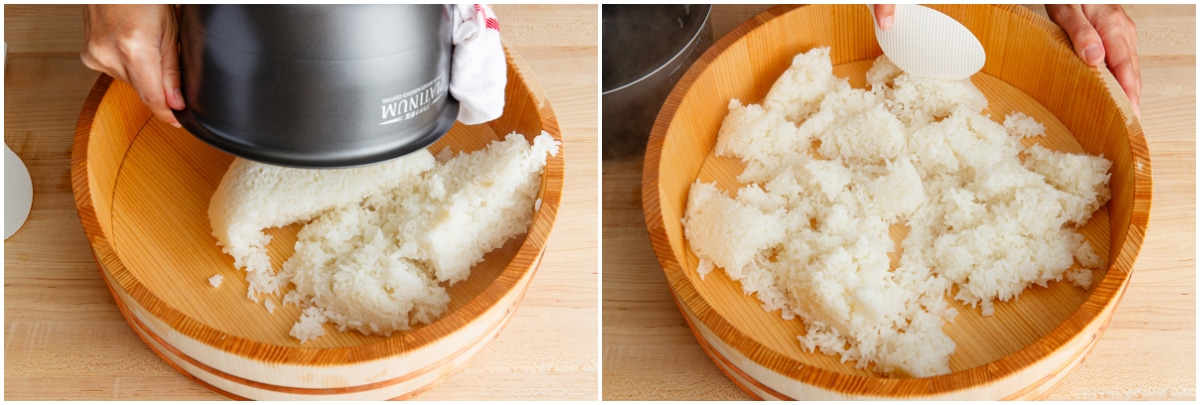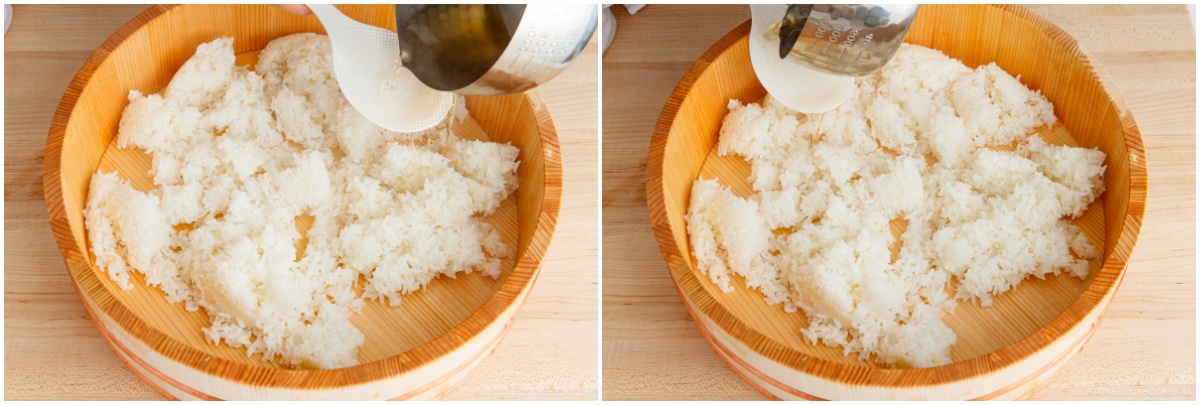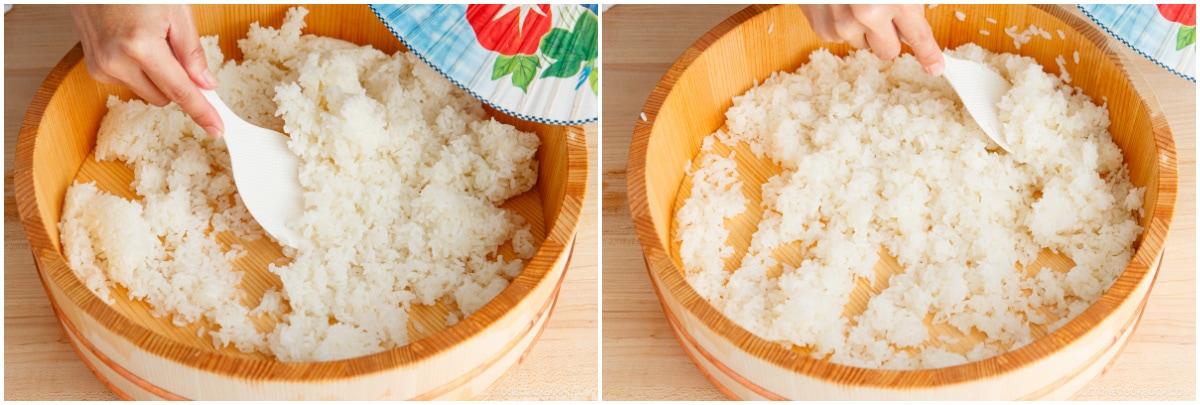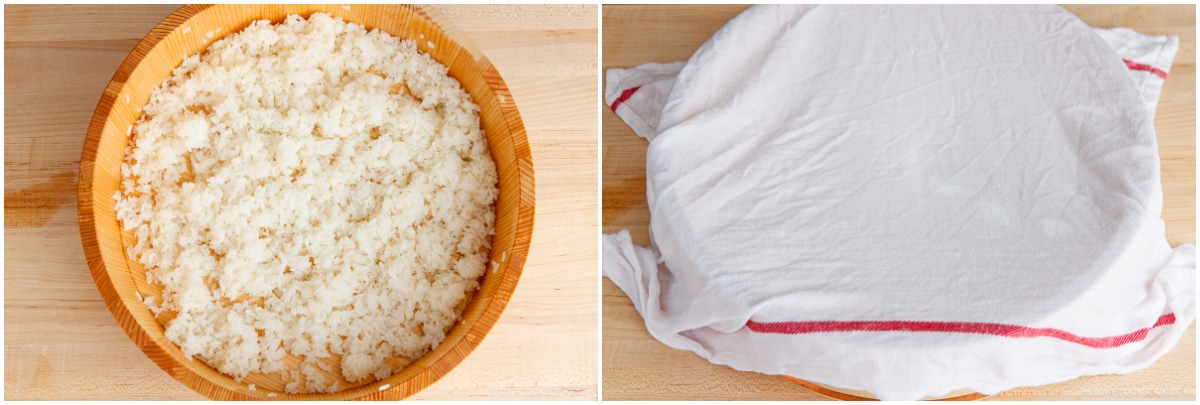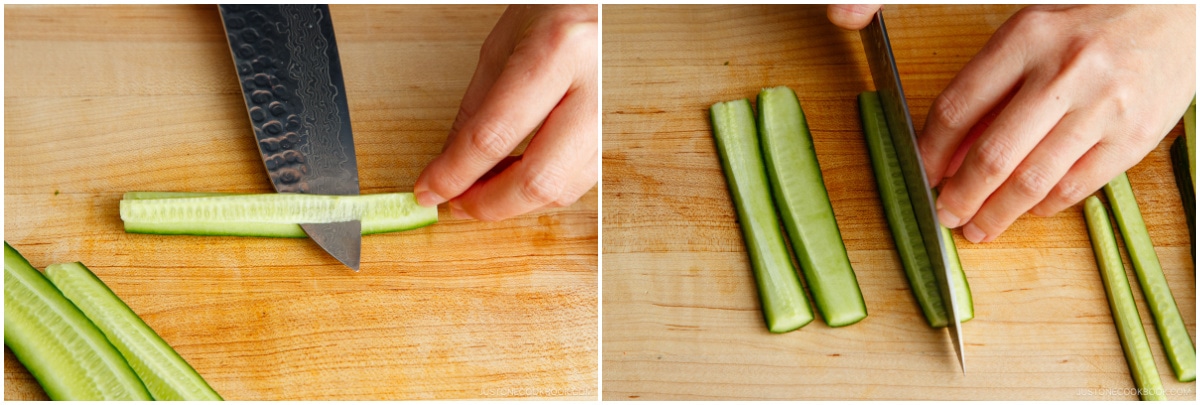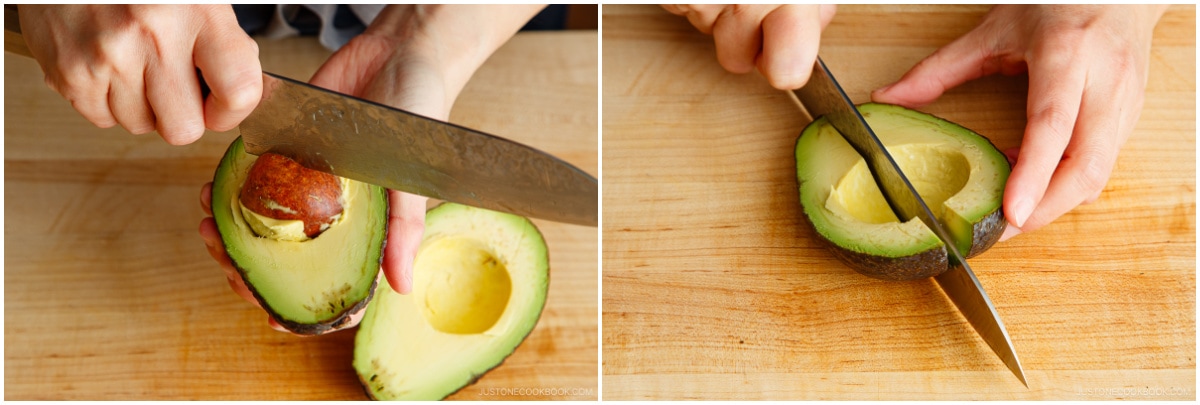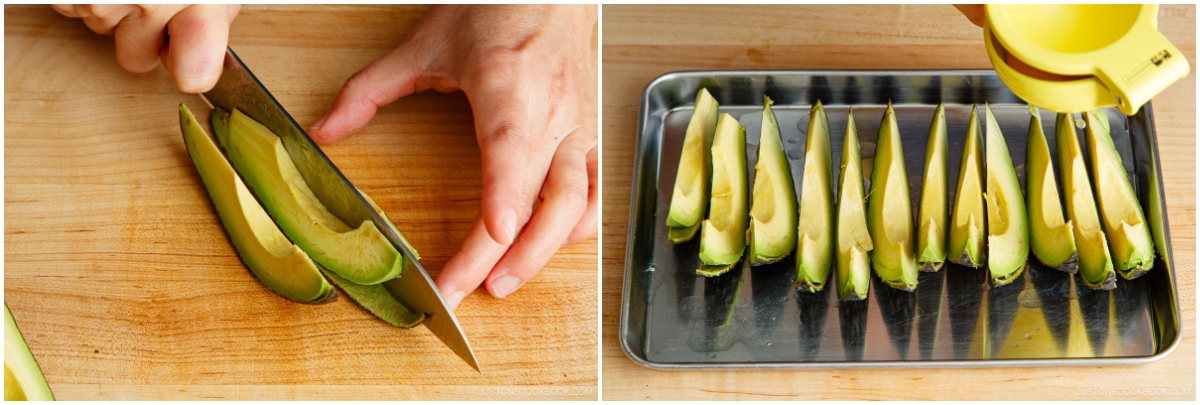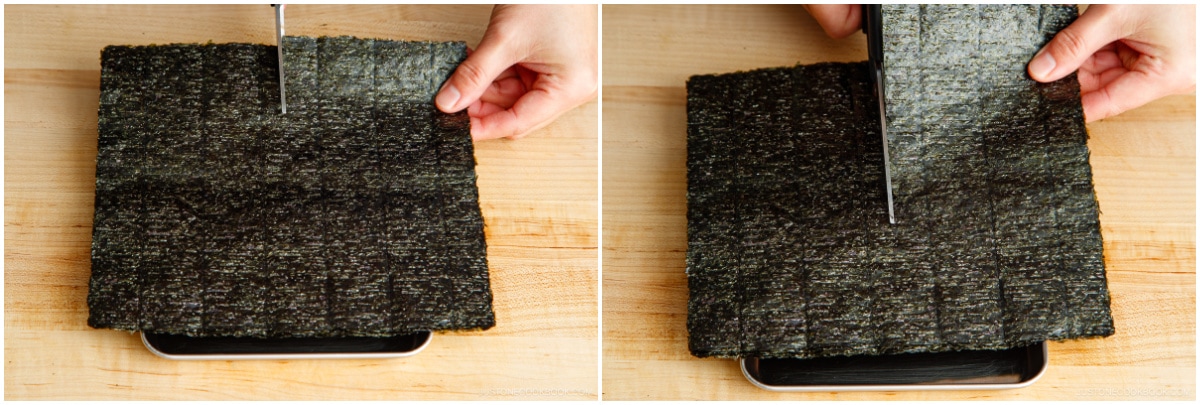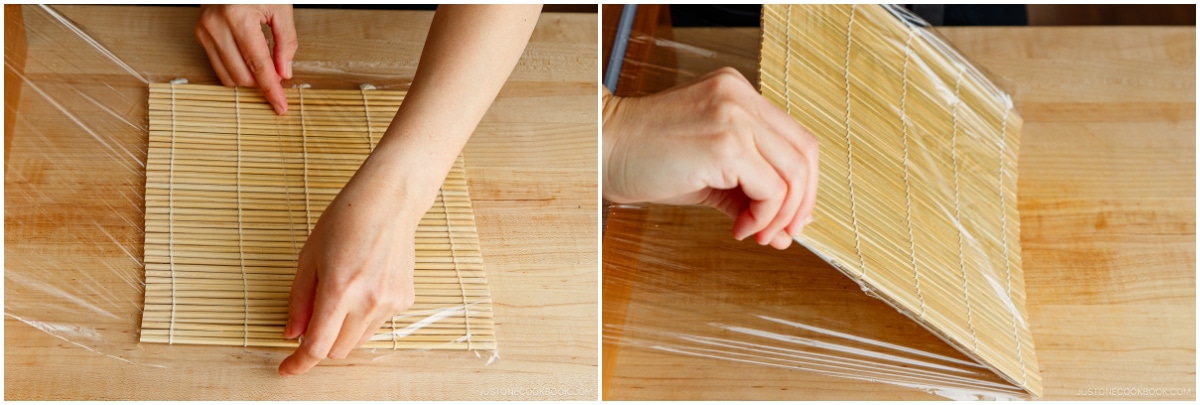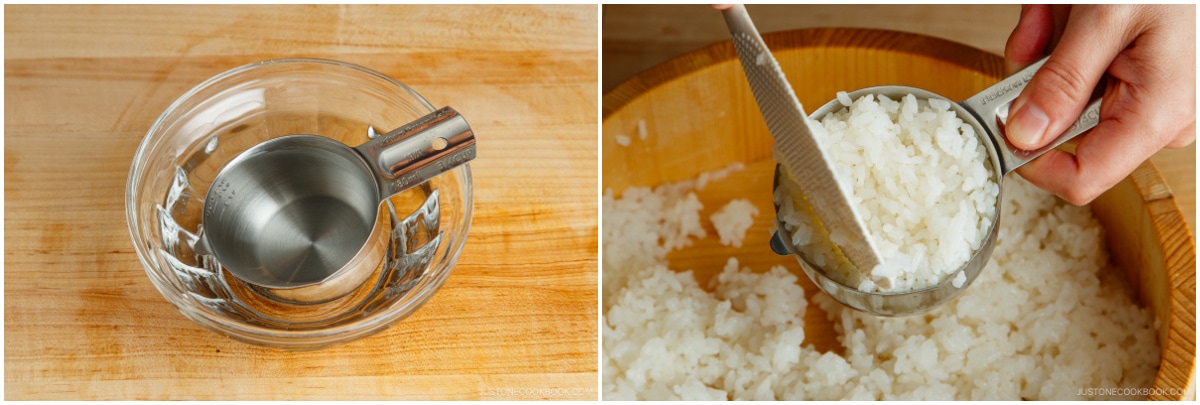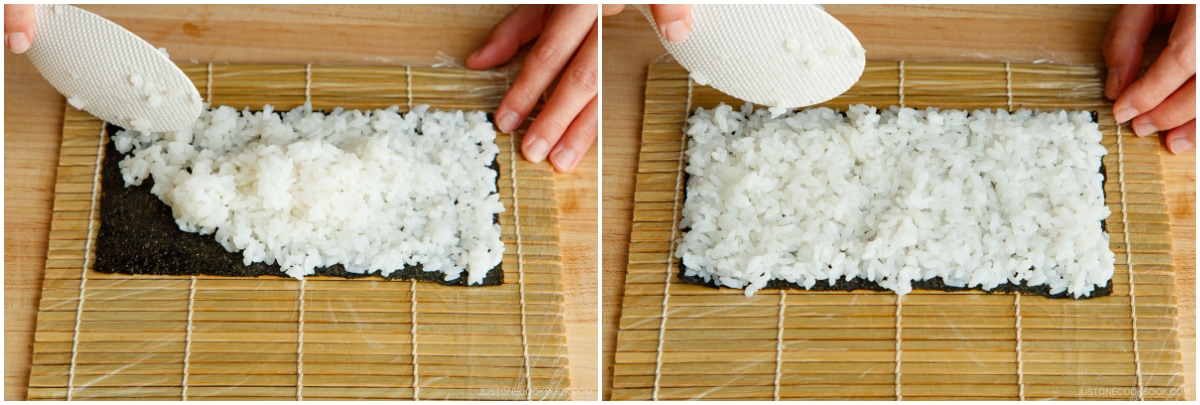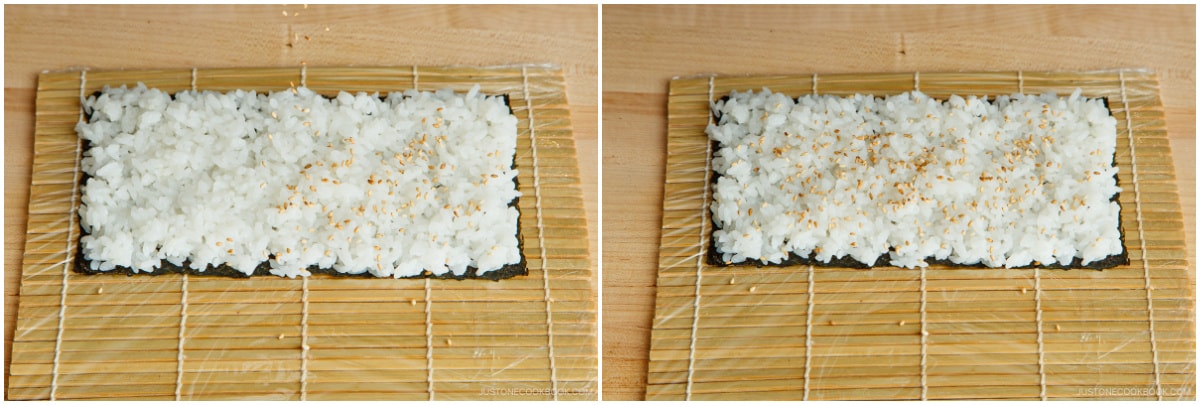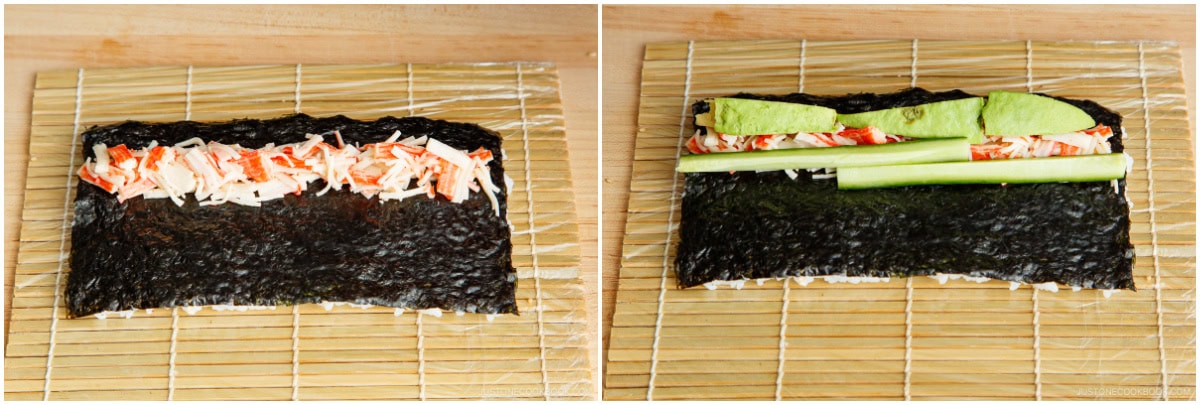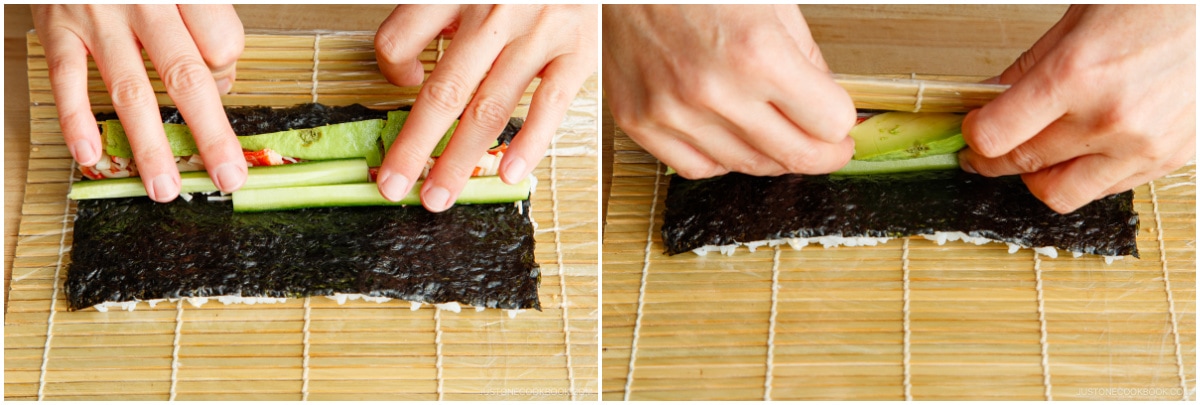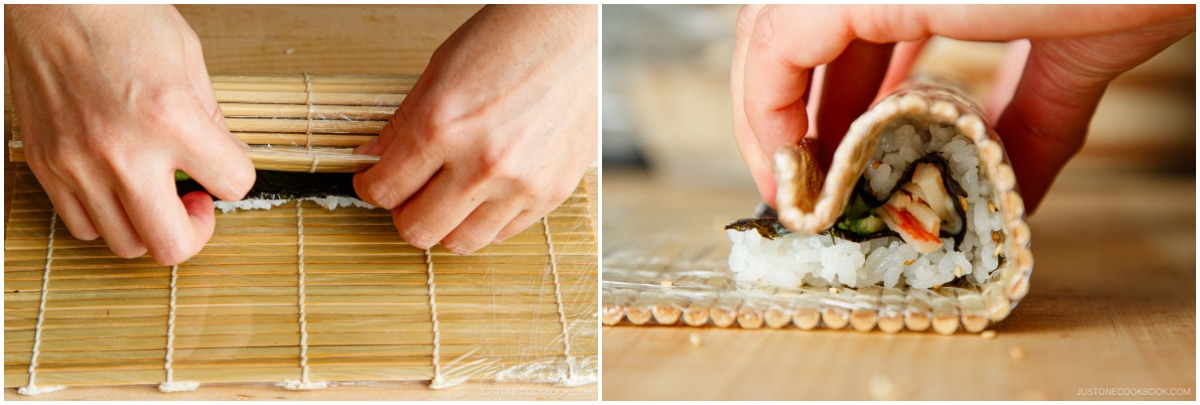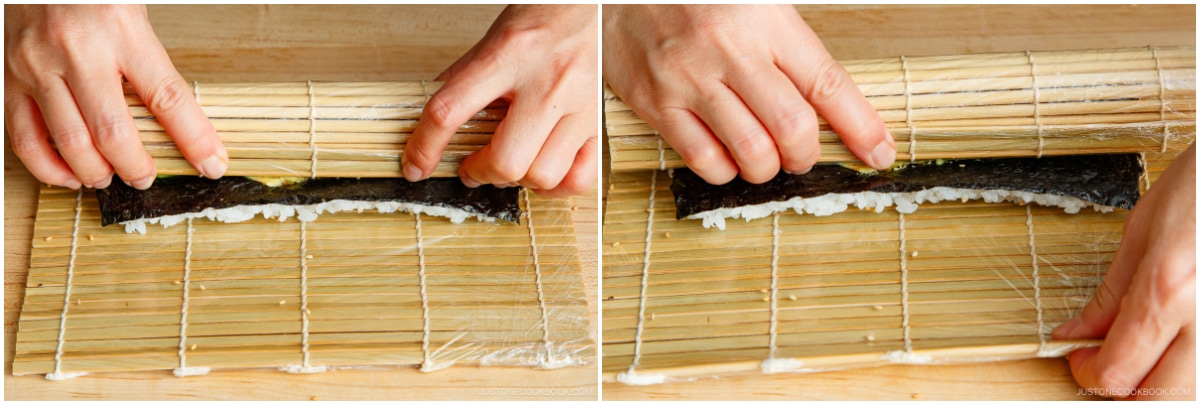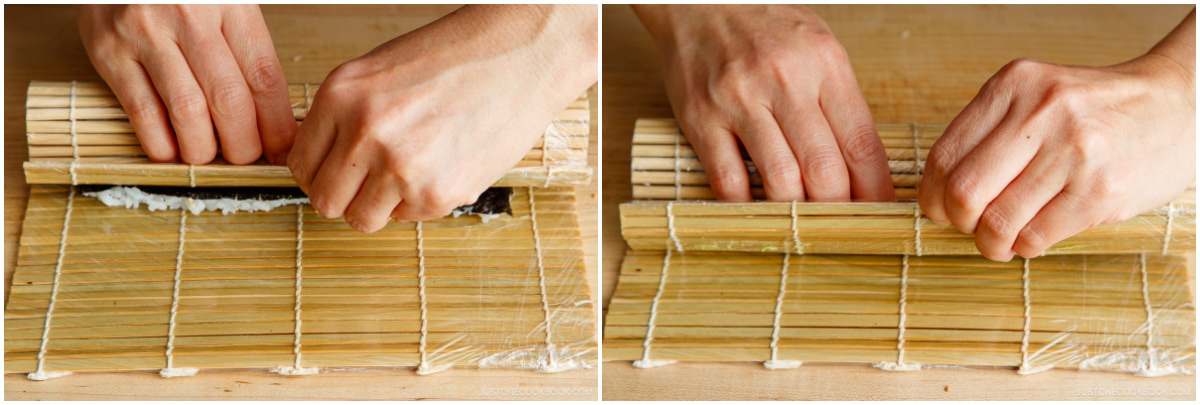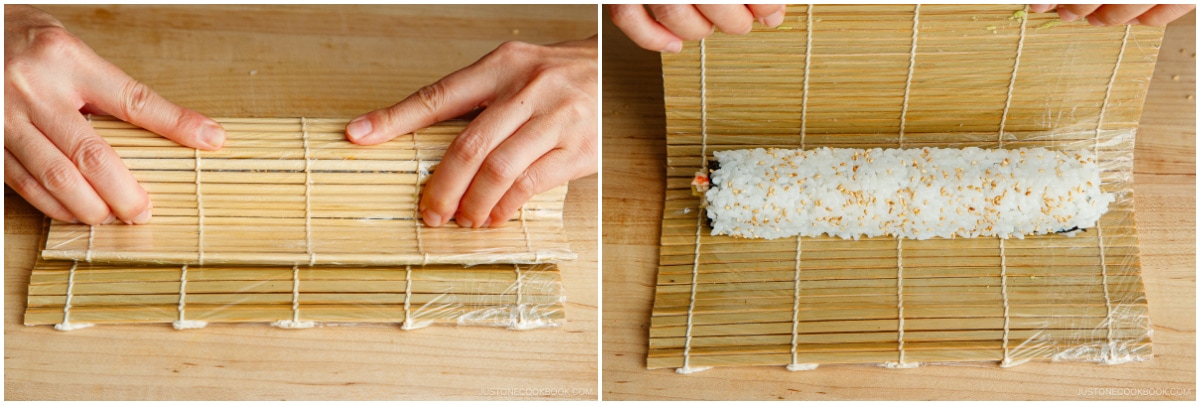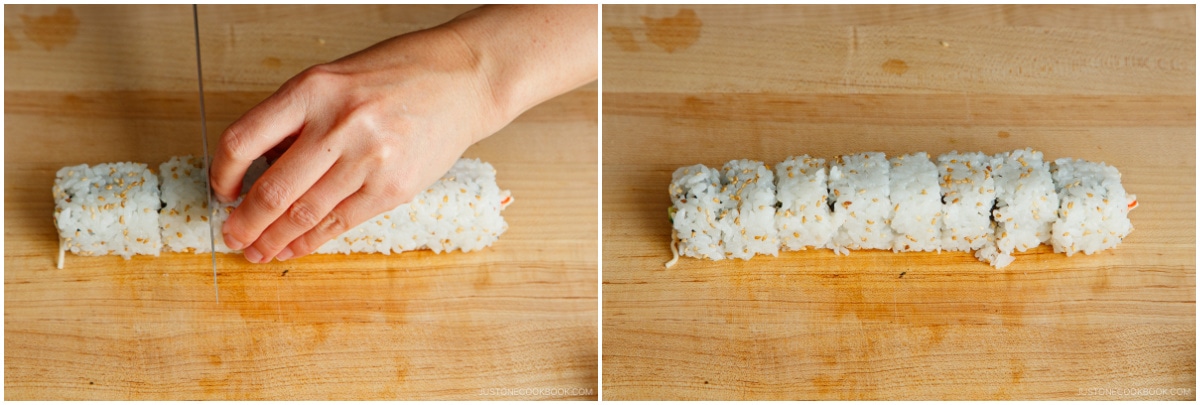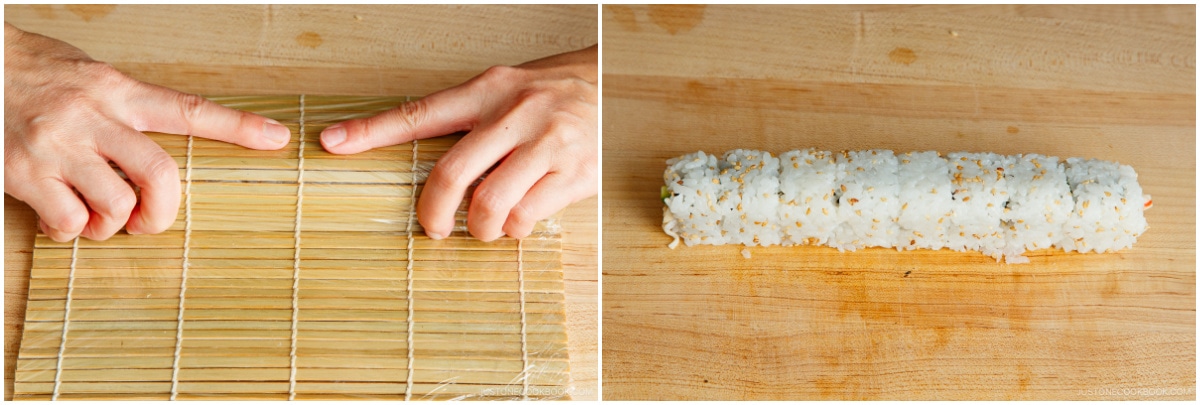What was the first sushi roll that you tried at a Japanese restaurant? For many of you, it might be California Roll (カリフォルニアロール), as it is probably by far the most popular style of sushi in the U.S. Today, I’ll show you how easy it is to make California rolls at home.
What is a California Roll?
California roll is a type of sushi roll (makizushi 巻き寿司 or rolled sushi in Japanese) made with seasoned sushi rice, crabmeat (real or imitation), avocado, and cucumber. It is an “inside-out” roll, known as uramaki (裏巻き), where the fillings and nori (dried roasted seaweed sheet) are rolled inside the sushi rice.
Who invented the California Roll?
Did you know many creatively named sushi rolls, such as the California Roll and Dragon Roll, do not originate from Japan? There are a few chefs who have been cited as the creators of the California Roll, but the facts remain unclear. Every account of the original California Roll is slightly different, and the sushi’s description also varies greatly from what we see today. The more recent and well-known story comes from Japanese-born sushi chef Hidekazu Tojo, a resident of Vancouver, who claims he created the California Roll at his restaurant in the late 1970s. He learned that most Western people didn’t eat raw fish and were not fans of nori seaweed. So, he substituted avocado for toro (fatty tuna) because it has a similar creamy texture. He hid the nori seaweed using the uramaki technique, ensuring that the nori was not visible outside.
Why do they call it a California Roll?
The sushi is called the “California Roll” because it consists of crab and avocado. The initials for these ingredients together are CA, which happens to be the abbreviation for the state of California. Thanks to this utterly random and uncanny coincidence, Chef Tojo decided to go with the name California Roll. That’s how the California roll turned into a popular menu item! In recent years, even fast-food-style sushi restaurants have started serving the California Roll on their menus. This tells the story of a successful adaptation and re-imagination of food.
What’s the difference between a Japanese sushi roll and a California roll?
You’ll find two main differences between a traditional Japanese sushi roll and a California roll: The most common styles of sushi rolls (makizushi) in Japan are Hosomaki (thin sushi roll) and Futomaki (big sushi roll), which feature various kinds of ingredients. As you can see, it’s quite different from the sushi roll menus in the United States!
Ingredients for California Roll
Unlike nigiri sushi or other sushi rolls, California rolls do not include raw fish. That means you can easily source the ingredients to make this sushi roll at home! Here are the key ingredients you need:
Seasoned sushi rice: Quality Japanese short-grain sushi rice is what you need to make the best sushi rice. I recommend koshihikari rice, such as Tamanishiki Super Premium Short Grain Rice and Tamaki Gold, but you can choose the more affordable options, such as Kokuho Rose and Nishiki.
Nori (toasted seaweed): High-quality nori has a delicate umami taste and does not taste fishy. I noticed that most grocery stores carry inexpensive nori, which becomes gummy when wrapped around the rice. If possible, I recommend getting the nori that’s imported from Japan. From my experience, it is far better than the ones available in English packaging.
Avocado: Use only ripe, ready-to-eat avocados so your sushi roll tastes fresh, smooth, and creamy.
Crab meat: You can use fresh, canned, or imitation. Unfortunately, I’m allergic to fresh crab meat, so I use imitation crab meat. Japanese crab-flavored surimi (I use the Kibun brand) has a great texture and flavor.
Japanese cucumbers: For sushi making, use thin and long Japanese cucumbers with fewer seeds instead of regular American cucumbers. If you can’t find Japanese cucumbers, Persian or English cucumbers (with the seeds removed) are acceptable alternatives.
Sesame seeds: If you have a few extra minutes, toast the sesame seeds in a non-greased frying pan until one or two seeds pop. This adds a wonderful nutty flavor and aroma.
Serve your California roll with Japanese soy sauce, wasabi, and pickled sushi ginger on the side.
Tools for Making California Roll
Bamboo sushi mat (makisu 巻き簾) – The Japanese sushi mat has flat and round sides. Plastic food wrap – To make inside-out rolls, we must cover the sushi mat with plastic wrap so the rice doesn’t stick. Sushi oke – You need to prepare sushi rice in it. You can use a large mixing bowl or salad bowl. Rice paddle – It’s not only needed for fluffing the freshly cooked rice, but it’s also useful to spread the rice evenly on the nori sheet. Damp towel – Cover the prepared sushi rice so it doesn’t get dry. Then, use it to clean the knife while slicing the sushi rolls.
Enjoy making sushi at home? You can buy a convenient sushi making kit of sushi oke, bamboo mat, and rice paddles.
How To Roll Sushi (Step-by-Step)
Put the sushi rice and filling:
Start rolling the sushi!
Check out my recipe card below for detailed instructions on how to assemble a sushi roll.
Tips for Making California Rolls
Many people feel intimidated by the sushi rolling process, but you can relax and take it one step at a time by following my recipe and tips. Here are important tips to remember:
Evenly distribute the sushi rice. The sushi roll will become lopsided if the rice and ingredients are not evenly spread out. Do not overstuff the sushi. It may seem basic, but you’d be surprised how easily we overstuff the sushi, making it difficult to seal the rolls. Start with a small amount of filling and gradually increase to an amount that you can easily roll. Roll the sushi compactly. If loosely rolled, the sushi roll may fall apart. Pull the bamboo mat in opposite directions and use tension to tighten the roll. Having a hard time rolling sushi? You can always make “regular” sushi rolls (forget “inside-out” sushi rolls) or use a 3/4–1 nori sheet instead of a half sheet. It’s much easier to handle!
Even though I make regular sushi rolls once in while, I find uramaki or inside-out rolls hard to make, and I think you can see my struggle a little in the pictures. Don’t worry, even though they don’t look like California rolls sushi chef make, they are equally delicious!
California Roll Variations
I love my California Roll to be more colorful. As you can see in the pictures, I placed ikura (salmon roe) on individual pieces of California Rolls after slicing. You can spread tobiko (fish roe) instead of sesame seeds. I used yuzu-flavored tobiko, so it’s yellow-colored tobiko instead of standard orange-colored tobiko. Since I use fish eggs (ikura/tobiko/masago) to decorate the sushi rice, I add toasted sesame seeds to the crab meat mixture. I love that these California Rolls look more lively than the standard style.
More Popular Sushi Recipes
I hope you enjoy making California rolls as they make a great appetizer or finger food for parties and potlucks! Here, I’d like to share other popular sushi recipes on Just One Cookbook.
Mosaic Sushi Temaki Sushi (Hand Roll Sushi) Inari Sushi Dragon Roll Sushi Rolls Ultimate Sushi Guide: Sushi Types, Recipes, and Etiquette
Wish to learn more about Japanese cooking? Sign up for our free newsletter to receive cooking tips & recipe updates! And stay in touch with me on Facebook, Pinterest, YouTube, and Instagram. Editor’s Note: This post was originally published on Aug 19, 2011. The content has been updated in May 2017. The post was updated with a revised recipe and more helpful content on April 1, 2024.
